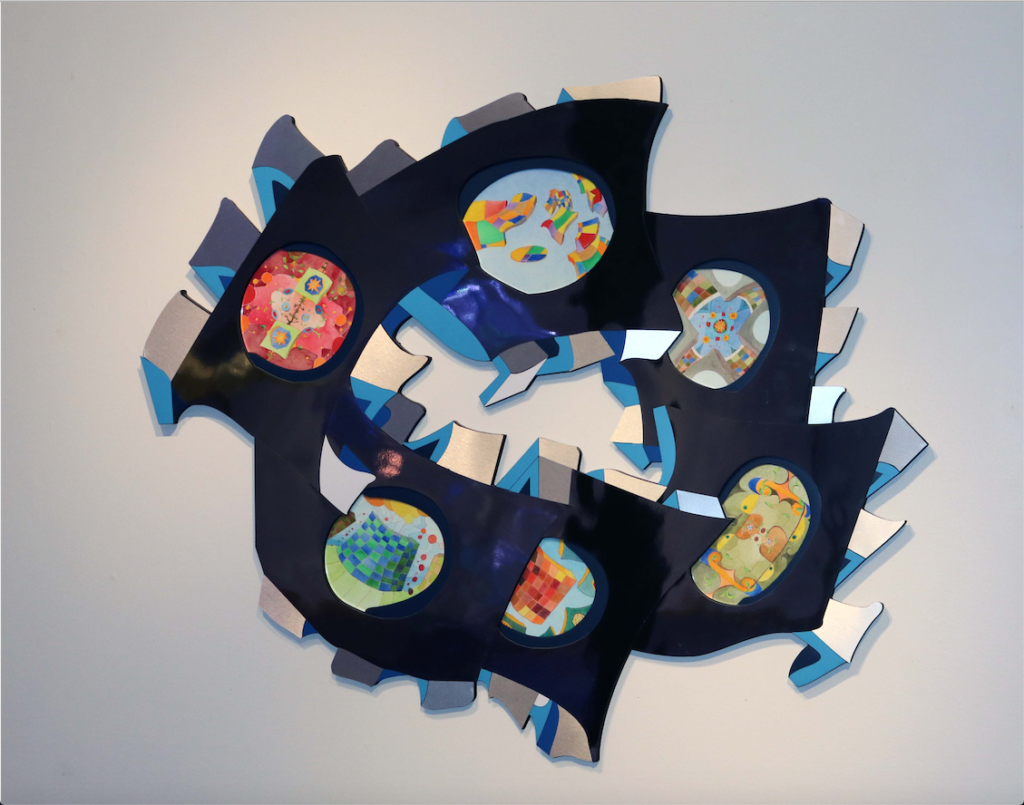When museumgoers cross the gallery threshold for “Digital Vision,” the newest exhibition at the Grinnell College Museum of Art (GCMoA), they are met by a hypnotic display of lights rippling in infrared, an experience immediately delivering on the apparent theme of the show.
Moments later, however, they see pieces that evoke a more “traditional” gallery setting, arriving in front of paintings, photographs and elaborate sculptures hung from the ceiling. Upon further examination, these apparent contrasts fade away as the role of technology in each piece is revealed.
“This exhibition is about broadening our vision [of art] to include both digital and analog,” said Susan Baley, director of the GCMoA, who helped open the exhibit on Jan. 28.
The exhibit, planned in collaboration with former GCMoA director Lesley Wright, was originally proposed as a showcase of Grinnell art professor Matthew Kluber’s artwork, in which he codes luminous, undulating videos and projects them onto paintings. The result is a dreamlike, intricate and ephemeral exploration of art’s new frontier, made only more impressive by how the works engage and contrast with one another.
As the planning process continued, Kluber invited six other artists that utilize digital tools in their creative processes to participate in the exhibit. At the museum, viewers can also see pieces by Bill Albertini, Kate Petley, John Pomara, John F. Simon Jr., Anne Spalter and Jody Zellen.
Throughout the semester, students will have the chance to hear the creators discuss their art and processes through the Artists@Grinnell program. The artists will present in pairs, a nod to the centrality of how the works themselves are “in conversation with one another,” said Baley.
All featured artists attended school and began their careers before the advent of technology that now plays a primary role in their featured work. Within this context, the exhibit ultimately depicts a movement in transition, featuring artists who have integrated technology to a greater extent as both their careers and technical innovation at large have progressed. Kluber shared how the proliferation of “very small and very reliable” computers not only opened the door for new projects, but also expanded opportunities for bringing the works into museum and home settings.
Although visitors are immediately greeted by the neon waves of Kluber’s paintings, a stroll through the gallery also reveals works that are not overtly identifiable as high-tech pieces, such as Bill Albertini’s “Save As,” a set of sculptures made up of nested, twisting bronze and stainless-steel pieces.
Diving into Albertini’s process, however, reveals a technologically sophisticated technique: Albertini models the pieces using an Oculus Rift virtual reality headset and produces them with a 3-D printer. In an interview, Albertini raised a common refrain for the participating artists: digital artwork allows creators to experiment with the nature of time.
In “Save As,” Albertini explained that his process of drafting, saving and returning to the different pieces in “Save As” mimicked the rhythm of a “stop-frame animation, in which each iteration changes but offers the opportunity to return to your draft and begin working again.”
Artist John F. Simon Jr. also engages with temporality in his works. His pieces exemplify the duality of digital artwork that is rendered and saved in code, but manifests in a display of “always changing, never-repeating patterns” upon screens nestled within intricate and colorful frames.
In an increasingly hurried world, it is easy to dismiss technology as a distraction that pulls us away from absorbing the transitory. “Digital Vision” not only challenges that assumption, but provides a canvas upon which to marvel at the fleeting.
Editor’s note: Previous versions of this article stated artist John F. Simon Jr.’s name as both John Simon Fraser Jr. and John Fraser Simon Jr., which have since been corrected. The S&B regrets these errors. Updated Feb. 9, 2022, 9:38 a.m.




































































